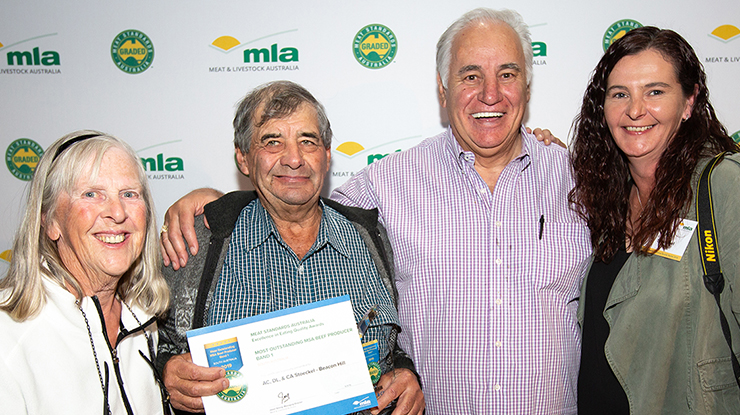Mallee beef producers claim MSA win
01 October 2019
 Dawn and Adrian Stoeckel, Sam Kekovich and Roz Stoeckel at the 2019 MSA Excellence in Eating Quality Awards in South Australia
Dawn and Adrian Stoeckel, Sam Kekovich and Roz Stoeckel at the 2019 MSA Excellence in Eating Quality Awards in South Australia
When the Stoeckel family transitioned from prime lamb production to beef thirteen years ago, becoming registered Meat Standards Australia (MSA) producers was a strategic business decision that continues to yield benefits.
Adrian and Dawn Stoeckel and their son Colin and his wife Roz, operate their beef and cropping business across the 9,000ha ‘Beacon Hill’, Swan Reach, in the Mallee region of South Australia.
The family partnership was awarded the 2019 MSA Excellence in Eating Quality Most Outstanding Beef Producer Award for SA for Band 1 producers, based on their MSA compliance of 99.5% and average MSA Index of 62.36.
The Stoeckels run a purebred Black Angus herd across 5,000ha of the farm, and crop around 3,000ha of wheat and barley, and 1,000ha rye and barley for grazing when needed.
They usually run around 400 breeders, but with rainfall tracking well below the annual average, they have reduced breeder numbers to around 250 head. Currently, they’re running a total of approximately 600 head which includes feedlot cattle, weaners and calves.
All of the Stoeckels’ cattle are bred on the property. Cattle turned off for processing go to Teys Australia’s Naracoorte facility, targeting 600kg + liveweight, supplying Teys Australia’s flagship South Australian beef brand, 36º South.
Taking its name from Naracoorte’s latitude reference, 36º South is underpinned by the MSA grading system.
The Stoeckels were recently recognised by Teys Australia with a Certificate of Excellence for the quality of their cattle supplying the brand and Adrian said having a good relationship with their processor has been important to their business.
“Teys have been absolutely fantastic to us. It’s one of the main reasons we’ve been able to achieve what we have – they make our marketing easy,” Adrian said.
Adrian attributes their exceptional rates of compliance to MSA to the temperament of their easy-care cattle and nutrition management.
“We’re on sandy loam country that runs through to grazing country,” Adrian said.
“A lot of our paddocks are up to 2,500 acres (1000ha) and there’s some bush country, so we’ve got to have cattle that you know are going to calve without any problems because we can’t check them every day.
“Our young cattle spend about 12 months in the paddock on grass, mainly native perennials and clovers with some medic sown over it and feed sown for the cattle in tough times.
“We feed them straw and molasses and a bit of urea when it’s dry like it is now, then they come into the feedlot and go onto a mix of grain, potatoes, straw, vetch, canola meal and vitamins.
“In good years, we put them in the feedlot at 420kg and they spend 80 to 90 days there and they’re up to where we want them to be, but at the moment they’re going in a lot lighter because there’s not much feed in the paddock.
“At the moment, they’re going in at around about 300kg to 350kg and spending 100 to 120 days in the feedlot.
“Again, because of the drought, we’ve been feeding out 20 bales of straw a week to our paddock cattle to supplement their feed.
“We grow our own straw and bale it up in the good years and stockpile it for seasons like we’re having now.”
Getting the nutrition mix right is one of Adrian’s top tips for achieving MSA compliance.
“When we first started, we were feeding them too much grain and potatoes, but we’ve mixed more straw in, added a little bit of vetch and canola meal and add vitamins in the mix and I think we’ve got it right now,” Adrian said.
“Once we saw we were producing some good cattle, we took the next step to produce even better cattle, and kept altering their diet till we got it right.
“Also, when we buy in bulls, we look for bulls with good breeding values for calving ease. This is particularly important, and we have very few calving problems as a result of it.”
Adrian said getting paid a premium for producing a high-end product through MSA was one of its many advantages, along with access to carcase feedback through the myMSA platform.
“I study our MSA feedback regularly. Our MSA Index averages around 61 and upwards, which we’re very pleased with. They dress out extremely well weight wise and quality wise.”


